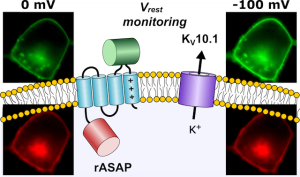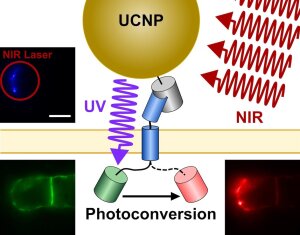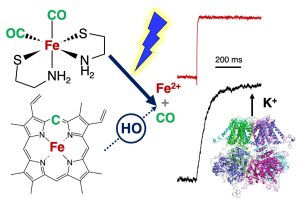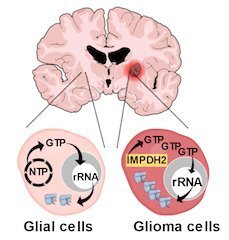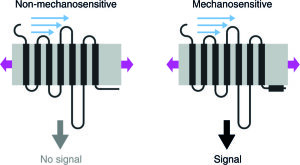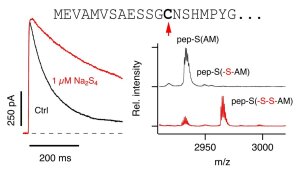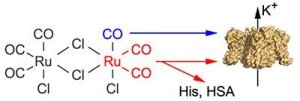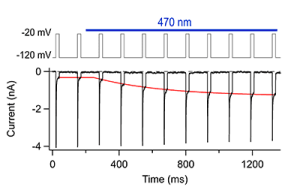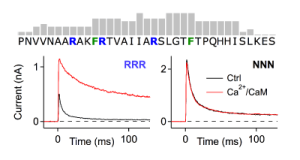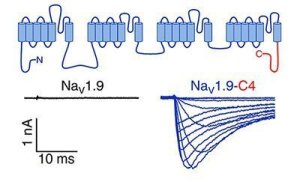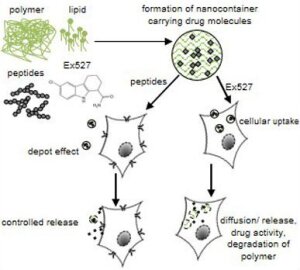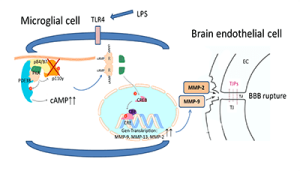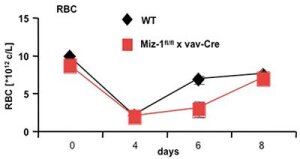Recent Research Highlights
Communications Biology 2021
Genetically Encoded Voltage Sensor
Illustration: Dept. of Biophysics/FSU JenaRühl P, Langner J, Reidel J, Hoshi T, Schönherr R, Heinemann SH
Monitoring of compound resting membrane potentials of cell cultures with ratiometric genetically encoded voltage indicators
Communications Biology (2021) 4:1164 (linkExternal link)
The electrical membrane voltage (Vm) is a decisive characteristic of excitable and nonexcitable cells as it determines direction and magnitude of ion transport across the membrane. Galvanic measurement of Vm, however, requires the access of an electrically conducting microelectrode to the cellular cytosol. Although routinely applied in various electrophysiological methods, this approach is not only severely invasive but also tedious and time-consuming, thus precluding the automatic evaluation of many cells in parallel. Here we present optimized genetically encoded voltage indicators that operate in a ratiometric fashion. Applied to cell cultures, compound Vm of several thousands of cells is readily measured. Furthermore, we show how ectopic expression of K+ channel mutants that cause neurodevelopmental disease such as the Temple-Baraitser syndrome (KV10.1) hyperpolarizes the cells. The introduced method also allowed monitoring the speed with which triggered expression of genes coding for K+ channels lead to an alteration of Vm.
Nano Letters 2021
Photoactivation of Dendra2 by NIR radiation of UCNPs
Illustration: FSU BiophysikDrees C, Rühl P, Czerny J, Chandra G, Bajorath J, Haase M, Heinemann SH, Piehler J
Diffraction-unlimited photomanipulation at the plasma membrane via specifically targeted upconversion nanoparticles
Nano Letters (2021) 21:8025-8034 (PubMedExternal link)
Frequency upconverting nanoparticles (UCNPs) utilize long-lived excited states of lanthanides to populate high-energy states of dopant ions (e.g. Tm3+ or Er3+) by subsequent absorption of near infrared (NIR) photons. UCNPs therefore have the potential to serve as local light sources when targeted to specific sites in biological environments. Here we demonstrate that UCNPs are suited to activate the photoconvertible fluorescence protein Dendra2 with a resolution below the optical diffraction limit. UCNPs were coated with non-fluorescent GFP to target them specifically to plasma membrane proteins tagged with antiGFP nanobodies. We showed that Dendra2 is also activated across the membrane when extracellularly bound UCNPs are excited with an NIR laser. These results identify UCNPs as exciting tools for bioanalytics, such as quantitative investigation of protein interaction kinetics and spatiotemporal organization at the micro- and the nanoscale, as well as the spatially confined, minimally invasive release of caged compounds.
Chemical Biology 2020
CORM-S1 releases CO and Fe2+, both of which activate BK channels
Illustration: Dept. of Biophysics/FSU JenaGessner G, Rühl P, Westerhausen M, Hoshi T, Heinemann SH
Fe2+-mediated activation of BKCa channels by rapid photolysis of CORM-S1 releasing CO and Fe2+
ACS - Chemical Biology (2020)15(8): 2098-2106 (PubMedExternal link)
Catabolism of heme by heme oxygenase results in the liberation of carbon monoxide (CO) and iron ions (Fe2+). Studying the impact of both mediators is not straightforward because of rapid diffusion and limited stability. Here we demonstrate that CORM-S1 (dicarbonyl-bis(cysteamine)iron(II)) is a useful chemical that precisely delivers CO and Fe2+ when illuminated with blue light. Fe2+, rapidly released from CORM-S1 in a flash-photolysis setting, activates BKCa channels with an efficacy much higher than CO. BKCa channels are therefore downstream targets of heme oxygenase and may connect heme signaling with electrical cell signaling. Physiologically relevant micromolar Fe2+ concentrations activate BKCa channels as much as unphysiologically high (> 2 mM) Mg2+ concentrations.
Nature Cell Biology 2019
Up-regulation of IMPDH2 in glioma cells drives de novo GTP production, rRNA synthesis and ribosome biogenesis. Normal glial cells sustain low rRNA synthesis via recycling of nucleotides.
Image: H. BierhoffKofuji S, Hirayama A, Eberhardt AO, Kawaguchi R, Sugiura Y, Sampetrean O, Ikeda Y, Warren M, Sakamoto N, Kitahara S, Yoshino H, Yamashita D, Sumita K, Wolfe K, Lange L, Ikeda S, Shimada H, Minami N, Malhotra A, Morioka S, Ban Y, Asano M, Flanary V,L, Ramkissoon A, Chow LML, Kiyokawa J, Mashimo T, Lucey G, Mareninov S, Ozawa T, Onishi N, Okumura K, Terakawa J, Daikoku T, Wise-Draper T, Majd N, Kofuji K, Sasaki M, Mori M, Kanemura Y, Smith EP, Anastasiou D, Wakimoto H, Holland EC, Yong WH, Horbinski C, Nakano I, DeBerardinis RJ, Bachoo RM, Mischel PS, Yasui W, Suematsu M, Saya H, Soga T, Grummt I, Bierhoff H, Sasaki AT
IMP dehydrogenase-2 drives aberrant nucleolar activity and promotes tumorigenesis in glioblastoma
Nature Cell Biology (2019) 21 1003-1014 (PubMedExternal link)
In many cancers, high proliferation rates correlate with elevation of rRNA and tRNA levels, and nucleolar hypertrophy. However, the underlying mechanisms linking increased nucleolar transcription and tumorigenesis are only minimally understood. Here we show that IMP dehydrogenase-2 (IMPDH2), the rate-limiting enzyme for de novo guanine nucleotide biosynthesis, is overexpressed in the highly lethal brain cancer glioblastoma. This leads to increased rRNA and tRNA synthesis, stabilization of the nucleolar GTP-binding protein nucleostemin, and enlarged, malformed nucleoli. Pharmacological or genetic inactivation of IMPDH2 in glioblastoma reverses these effects and inhibits cell proliferation, whereas untransformed glia cells are unaffected by similar IMPDH2 perturbations. Impairment of IMPDH2 activity triggers nucleolar stress and growth arrest of glioblastoma cells even in the absence of functional p53. Our results reveal that upregulation of IMPDH2 is a prerequisite for the occurrence of aberrant nucleolar function and increased anabolic processes in glioblastoma, which constitutes a primary event in gliomagenesis.
Nature Communications 2019
Mechanosensation of GPCRs depends on the presence of an intact H8.
Image: CMB/Mol. Cell Biol.Erdogmus S, Storch U, Danner L, Becker J, Winter M, Ziegler M, Wirth A, Offermanns S, Hoffmann C, Gudermann T, Mederos y Schnitzler M
Helix 8 is the essential structural motif of mechanosensitive GPCRs
Nature Communications (2019) 10 5784 (PubMedExternal link)
G-protein coupled receptors (GPCRs) are versatile cellular sensors for chemical stimuli, but also serve as mechanosensors involved in various (patho)physiological settings like vascular regulation, cardiac hypertrophy and preeclampsia. However, the molecular mechanisms underlying mechanically induced GPCR activation have remained elusive. Here we show that mechanosensitive histamine H1 receptors (H1Rs) are endothelial sensors of fluid shear stress and contribute to flow-induced vasodilation. At the molecular level, we observe that H1Rs undergo stimulus-specific patterns of conformational changes suggesting that mechanical forces and agonists induce distinct active receptor conformations. GPCRs lacking C-terminal helix 8 (H8) are not mechanosensitive, and transfer of H8 to non-responsive GPCRs confers, while removal of H8 precludes, mechanosensitivity. Moreover, disrupting H8 structural integrity by amino acid exchanges impairs mechanosensitivity. Altogether, H8 is the essential structural motif endowing GPCRs with mechanosensitivity. These findings provide a mechanistic basis for a better understanding of the roles of mechanosensitive GPCRs in (patho)-physiology.
Pflügers Archiv – European Journal of Physiology 2019
Yang 2019
Image: Dept. of Biophysics/FSU JenaYang K, Coburger I, Langner JM, Peter N, Hoshi T, Schönherr R, Heinemann SH
Modulation of K+ channel N-type inactivation by sulfhydration through hydrogen sulfide and polysulfides
Pflügers Archiv (2019) 471 557-571 (PubMedExternal link)
Hydrogen sulfide (H2S), which is enzymatically produced in various tissues, is increasingly recognized as an important signaling molecule in the cardiovascular and nervous systems. Here we show that H2S and its oxidized sulfur species polysulfides potently remove A-type potassium channel inactivation. Such channels determine action potential frequency in excitable cells. Polysulfides at nanomolar concentrations impair A-type channel inactivation by sulfhydrating cysteine residues in their N-terminal ball-and-chain domains. H2S and polysulfides therefore could be potent modulators of cellular electrical excitability by altering the availability of A-type channels and their kinetics of inactivation.
European Journal of Pharmacology 2017
Dual effects of tricarbonyldichlororuthenium(II) dimer (CORM-2) on voltage-dependent potassium channels. Channel modification may result from binding of either carbon monoxide (blue) and/or of Ru(CO)2 fragments (red). The latter involves adduction to target histidines and, thus, can be quenched by excess free histidine or histidine-containing proteins such as human serum albumin.
Image: Dept of Biophysics/FSU JenaGessner G, Sahoo N, Swain SM, Hirth G, Schönherr R, Mede R, Westerhausen M, Brewitz HH, Heimer P, Imhof D, Hoshi T, Heinemann SH
CO-independent modification of K+ channels by tricarbonyldichlororuthenium(II) dimer (CORM-2)
European Journal of Pharmacology (2017) 815 33-41 (PubMedExternal link)
Carbon monoxide (CO), despite its toxicity, may serve as physiological messenger. To study the underlying molecular mechanism and for potential medicinal application, so-called CORMs (CO-releasing molecules), like tricarbonyldichlororuthenium(II) dimer (CORM-2), have been developed and frequently used. Using the patch-clamp technique, we show that for several K+ channels most of the functional impacts of CORM-2 are not mediated by CO but result from intermediate breakdown products: CORM-2 has the propensity of forming Ru(CO)2 adducts to histidine residues, as demonstrated using mass spectrometry. This off-site effect is completely abolished by excess free histidine or human serum albumin. Such adduct-formations may have been misinterpreted as CO gas effects in many previous and still ongoing studies, necessitating a re-assessment of derived interpretations thereof.
Scientific Reports 2017
Pulse protocol (top) and current recordings of roNaV2 channels in HEK293 cells (bottom). The blue bar marks illumination of the cell with blue light via a 63x objective. The red curve is a mono-exponential fit to describe the time course of inactivation loss upon illumination.
Image: Dept of Biophysics/FSU JenaOjha NK, Leipold E, Schönherr R, Hoshi T, Heinemann SH
Non-photonic sensing of membrane-delimited reactive species with a Na+ channel protein containing selenocysteine
Scientific Reports (2017) 7 46003 (PubMedExternal link)
The detection of cellular reactive species (RS), either endogenously produced or generated by illuminating cells during life-cell fluorescence imaging, is a demanding task because of the labile nature of RS. To measure the influence of RS and the impact of blue light close to the plasma membrane we introduce here a voltage-gated Na+ channel harboring a selenocysteine in its inactivation motif: roNaV2. Current measurements of roNaV2 yield ratiometric signals that report on local occurrences of RS without the need for confounding cell illumination. In addition, roNaV2 is reversible and its sensitivity towards light can be switched on and off by means of the electrical membrane voltage.
Scientific Reports 2015
Score pattern for potential calmodulin binding to the N terminus of Kvβ1.1 (top) and current recordings of Kv1.1+Kvβ1.1 channels with and without Ca(2+)/CaM for wild-type Kvβ1.1 (left) and after replacement of three asparagine residues for arginine (right).
Image: Dept of Biophysics/FSU JenaSwain SM, Sahoo N, Dennhardt S, Schönherr R, Heinemann SH
Ca2+/calmodulin regulates Kvβ1.1-mediated inactivation of voltage-gated K+ channels
Scientific Reports (2015) 5 15509 (PubMedExternal link)
Some auxiliary β subunits of voltage-gated K+ channels equip them with a rapid N-type inactivation mechanism, thus limiting K+ outward flow upon stimulation. Here we show that an elevation of the intracellular Ca2+ concentration removes Kvβ1.1-induced inactivation. This process is mediated by the Ca2+-binding protein calmodulin (CaM) binding to the “chain” element of the Kvβ1.1 N terminus, which normally operates as a “ball-and-chain” inactivation structure. By means of Kvβ1.1 subunits, voltage-gated K+ channels in neurons therefore are capable of functioning as negative feedback regulators to limit neuronal excitation and Ca2+ overload.
Pflügers Archiv - European Journal of Physiology 2015
Representative current traces measured in the whole-cell mode in response to depolarizations ranging from -127 to 3 mV of HEK 293T cells expressing human NaV1.9 (left) or chimera NaV1.9-C4 (right).
Image: Dept of Biophysics/FSU JenaGoral RO, Leipold E, Nematian-Ardestani E, Heinemann SH
Heterologous expression of NaV1.9 chimeras in various cell systems
Pflügers Archiv – European Journal of Physiology (2015) 467 2423-2435 (PubMedExternal link)
Voltage-gated sodium channel NaV1.9 is expressed in nociceptive neurons and thus plays an important role in the processing of neuronal signals leading to the sensation of pain. However, systematic investigations of NaV1.9 in isolation have been hampered because of unsuccessful expression in non-neuronal host cells. Here we show that a chimera of NaV1.9, harboring the C-terminal domain of skeletal muscle NaV1.4, yields functional channels when expressed in Xenopus oocytes and HEK 293T cells. This chimera largely conserves the functional properties of NaV1.9 as far as channel activation and pore pharmacology are concerned, thus providing a model system for research on NaV1.9 channels.
Macromolecular Bioscience 2014
Encapsulation methods for bioactive compounds into polymers
Image: Dept of Biochemistry/FSU JenaHennig D, Schubert S, Dargatz H, Kostenis E, Fahr A, Schubert US, Heinzel T, Imhof D
Novel insights into appropriate encapsulation methods for bioactive compounds into polymers: a study with peptides and HDAC inhibitors
Macromolecular Bioscience (2014) 14 69-80 (PubMedExternal link)
The use of different nanoparticles (NPs) for successful encapsulation of bioactive substances is discussed. The inclusion efficiency into liposomes, acetalated dextran (Ac-Dex), and variants of poly[(lactic acid)-co-(glycolic acid)] (PLGA) NPs is analyzed after chemical degradation. Efficient inclusion of SIRT1 inhibitor Ex527 in liposomes, Ac-Dex- and PLGA-NPs is observed for all procedures used. Activity of Ex527 is demonstrated by monitoring the acetylation status of SIRT1-target p53. In contrast, small peptides are only incorporated into acid-terminated PLGA-NPs and marginally into Ac-Dex-NPs. The yield depends on peptide sequence and terminal modifications. Activity is exemplified for angiotensin II using the dynamic mass redistribution technology.
NeuroMolecular Medicine 2014
Frister 2014
Image: Institute of Molecular Cell Biology/UKJFrister A, Schmidt C, Schneble N, Brodhun M, Gonnert FA, Bauer M, Hirsch E, Müller JP, Wetzker R, Bauer R
Phosphoinositide 3-kinase gamma affects LPS-induced disturbance of blood-brain barrier via lipid kinase-independent control of cAMP in microglial cells
Neuromolecular Medicine (2014) 16 704-713 (PubMedExternal link)
The breakdown of the blood-brain barrier (BBB) is a key event in the development of sepsis-induced brain damage. BBB opening allows blood-born immune cells to enter the CNS to provoke a neuroinflammatory response. Abnormal expression and activation of matrix metalloproteinases (MMP) was shown to contribute to BBB opening. Using different mouse genotypes in a model of LPS-induced systemic inflammation, our present report reveals phosphoinositide 3-kinase γ (PI3Kγ) as a mediator of BBB deterioration and concomitant generation of MMP by microglia. Unexpectedly, microglia expressing lipid kinase-deficient mutant PI3Kγ exhibited similar MMP regulation as wild-type cells. Our data suggest kinase-independent control of cAMP phosphodiesterase activity by PI3Kγ as a crucial mediator of microglial cell activation, MMP expression and subsequent BBB deterioration. The results identify the suppressive effect of PI3Kγ on cAMP as a critical mediator of immune cell functions.
American Journal of Blood Research 2014
Kosan 2014
Image: Dept of Biochemistry/FSU JenaKosan C, Rashkovan M, Ross J, Schaffer AM, Saba I, Lemsaddek W, Trudel M, Möröy T
The transcription factor Miz-1 is required for embryonic and stress-induced erythropoiesis but dispensable for adult erythropoiesis
American Journal of Blood Research (2014) 4 7-19 (PubMedExternal link)
Myc-interacting zinc finger protein 1 (Miz-1) is a BTB/POZ domain transcription factor that regulates complex cellular processes such as proliferation and apoptosis. Constitutively Miz-1-deficient animals arrest embryonic development at E14.5 due to severe anemia and fetal liver cells lacking Miz-1 show a high cell death rate and a significant reduction of mature erythroid cells. Mice with conditional Miz-1 alleles deleted around E14.5 were born at normal ratios, but had reduced numbers of erythrocytes, and showed an increase in reticulocytes in the peripheral blood. When challenged with the hemolytic agent phenylhydrazine (PHZ), Miz-1-deficient mice responded with a severe anemia. In addition, an accumulation of immature erythroid cells occurred in the bone marrow and spleen. Epo-signaling is the essential pathway for erythrocyte maturation and we could show that Miz-1 regulates Epo-signaling through Stat5 phosphorylation.
Taken together, Miz-1 is an important factor for erythroid differentiation and maturation. Moreover, Miz-1 is necessary to maintain a peripheral red blood cell homeostasis in particular in response to oxidative stress.
Biochimica et Biophysica Acta - Biomembranes 2014
Pulse protocol (top) and current recordings of roNaV2 channels in HEK293 cells (bottom).
Image: Dept of Biophysics/FSU JenaOjha NK, Nematian-Ardestani E, Neugebauer S, Borowski B, El-Hussein A, Hoshi T, Leipold E, Heinemann SH
Sodium channels as gateable non-photonic sensors for membrane-delimited reactive species
Biochimica et Biophysica Acta - Biomembranes (2014) 1838 1412-1419 (PubMedExternal link)
The current study presents a ratiometric sensor of intracellular reactive species (RS) levels based on genetically engineered voltage-gated sodium channels (roNaV). roNaV can be used for detecting oxidative modification that occurs near the plasma membrane with a sensitivity similar to existing fluorescence-based sensors. roNaV does not need excitation light for sensing, and thus, can be used to detect phototoxic cellular modifications. The RS dynamic range of roNaV is easily manipulated by means of the endogenous channel inactivation mechanism. Moreover, roNaV was used to assess RS lifetime in individual mammalian cells.
